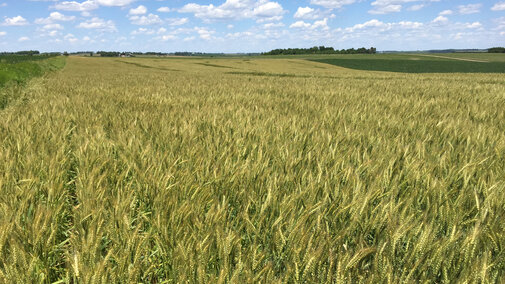Winter wheat yields across Nebraska are projected by USDA-NASS to be down 8 bushels per acre from last year’s record yield of 54 bushels per acre. Last year the three eastern crop reporting districts yielded 54.0, 60.3, 57.5 bushels per acre for Northeast, East Central, and Southeast, respectively. These were record yields for the East Central and Southeast Nebraska Crop Districts.
While final USDA yield numbers aren't in yet, it looks like 2017 wheat yields could rival the 2016 yields in portions of eastern Nebraska, based on state variety trials and extension educator reports. State variety trials in east central and southeast Nebraska yielded 66 bu/ac in 2016, but yielded 100 bushels per acre in 2017 (2017 Fall Seed Guide). The UNL variety trials are replicated small plots that may not reflect whole field averages in some cases, but obviously remain a good method for comparing wheat varieties.
Northeast and East Central Nebraska
Wheat grown in these two districts only makes up a little more than 20% of the eastern Nebraska wheat acres. Growers found wheat yields this July ranging from 90 to 110 bushels per acre for field averages. Looking back on the season, above average rainfall during August and September created a full soil moisture profile going into wheat planting. Most winter wheat acres were planted the second week of October.
Warm and wet conditions in November and a warm February helped the wheat get off to a great start. Wheat maturity was such that the late cold snap in April did not cause any significant damage. Powdery mildew and stripe rust were the two troublesome diseases in this area due to the wet conditions in April and May, though many growers did spray a fungicide to control stripe rust. A warm dry period hit just prior to flowering in late May and extended until Mid-June. This largely put a damper on Fusarium head blight issues this year. In spite of the hot temperatures in June (2 to 4 degrees above normal), wheat yields were excellent. And, while rain in early July delayed some wheat harvest, it was wrapped up by mid July.
Southeast Nebraska
Wheat grown in the southeast district makes up nearly 80% of the eastern Nebraska wheat acres. The southeast Nebraska wheat crop yielded less than the 2016 bumper crop, but was still good to above average in the 50 to 65 bu/ac range. (Reports ranged from 28 to 91 bu/ac depending on location and management intensity.) Test weights were very good, but did drop in some fields where rain delayed harvest in July. Some protein levels were high enough to receive a premium price.
A few fields were diagnosed with wheat streak mosaic disease spread by the wheat curl mite from adjacent volunteer wheat that was not terminated at planting time last fall. This, along with mild fall weather, allowed for wheat to become infected. Some yield loss was also attributed to a combination of variety selection and a lack of timely foliar fungicide use.
A few other lower yielding fields were diagnosed with sulfur deficiency. This has become more common over the last five years in this area, but can be corrected with early-season applications. These challenges did not constitute a large number of acres. It is also important to note that wheat is often grown on more challenging and highly erodible soils where farmers are looking for opportunities to include double crop soybeans, plant cover and forage crops, apply manure, and do conservation work.

